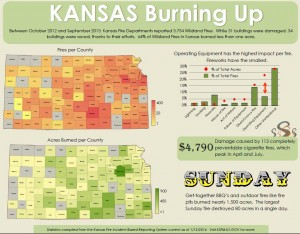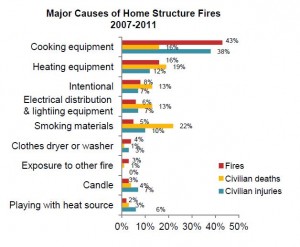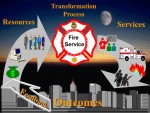By: Sara Wood, Kansas NFIRS Program Manager
There have always been issues when it comes to data quality and the National Fire Incident Reporting System (NFIRS): Incomplete reports,  blank fields, “Unknown” responses, etc. It’s rampant. There are dozens of articles about the quality of NFIRS data being a problem.
blank fields, “Unknown” responses, etc. It’s rampant. There are dozens of articles about the quality of NFIRS data being a problem.
We know it’s a problem. It’s always been a problem. However, NFIRS information influences countless prevention campaigns, safety product development, code development, and a host of other areas so it is far past time to take NFIRS seriously. We must set complaints of data quality aside and take action.
Do you feel your department is too small to matter for NFIRS? Let’s say you run ten calls a year. If every department that runs ten calls a year felt too small for NFIRS, we are not talking about a “small” amount of reports anymore.

National Fire Protection Association. Major Causes of Home Structure Fires
2007-2011. www.nfpa.org. Click to enlarge image
This is a National program, so any problems from the local level only become magnified. If one report in ten were incomplete it might not feel like a problem to a single department, but if one in ten reports were incomplete at the national level we’re talking roughly 2.3 million reports that can’t be used. That’s not such a small problem.
The scope of NFIRS data usage is vast and sometimes unexpected. A quick Google search for “NFIRS statistics” will yield over 17,000 results. Here are some examples:
- Barn Fire Prevention Month based on NFIRS data, sponsored by the Horse Safety USA, advocates for precautionary planning, education on the issue, and taking necessary steps to reduce barn fires such as having fire extinguishers, smoke detectors, and posting No Smoking signs. This is a shining example of measuring a problem and addressing root causes.
- Infrared Thermography has been applied to home electrical evaluations prior to a fire occurring, leading to prevention of electrical fires. Studies were based on NFIRS information, backing this major cause of building fires with facts and statistics.
- The Building Lightning Safe Communities campaign encourages reporting to NFIRS to help create awareness.
- Reauthorization of the Assistance to Firefighters Grant (AFG) Program will rely, and has relied, on proving the need. The Fire Service must advocate for itself with facts. How else can this be done without NFIRS? (BTW, did you know that a prerequisite for applying for an AFG grant is that your department must be submitting its fire data to NFIRS?)
- The passage of Reduced Ignition Propensity (RIP) cigarette legislation (safe cigarettes) is happening in many states. Indeed, my home state of Kansas has legislation in place mandating safe cigarettes. Not incidentally, smoking fires are a leading cause of fatal fires.
- Allocating Prevention/Inspections to larger problems identified through NFIRS can stretch limited resources. NFIRS can help track what building type or geographical area is experiencing more issues.
Does it really impact you?
Ok, so not every department is performing inspections, running prevention education campaigns, or applying for grants. Even if you don’t

This model depicts the process where by resources are provided to the Fire Department leadership who are responsible for the transformation of those resources into service delivery necessary to achieve desired outcomes. Source: Fire Service Financial Management class, National Fire Academy, 2003.
use NFIRS data directly, somebody is still looking at numbers, still working on a product, still trying to quantify the fire problem to fight it.
We all enjoy safer firefighting equipment that’s been developed from studying fire service deaths and injuries. Your local population still sees or might participate in prevention campaigns run by other agencies or non-profit organizations. New constructions still have to be built to current codes with standards meant to increase public safety and decrease fire risk. You may not believe it, but your population and department are directly impacted by NFIRS, even if you can’t see it.
Improving NFIRS Reports
It’s time to get serious about methodically improving NFIRS. Incorrect reports muddy the water and can keep real problems hidden. Use these strategies for improving reporting:
- Support starts from the top. Leaders in the fire service must be vocal about the importance of NFIRS. Chiefs, officers, fire schools, academies, everywhere and everyone. Talk about your support for the improvement of NFIRS. Make NFIRS one of the first topics you cover with a new recruit as part of the Fire Service History.
- Develop and use a good field notes form. Data quality starts on the call. A good field notes form can be the difference in a complete report and a complete mess. Good field notes can also dispel the “3 a.m. data quality problem”. With enough information and a narrative on a field form you can go home and sleep, rather than sitting down to a computer in the middle of the night. The NFIRS Incident Field Notes form is available for use or as an example. Find it here: http://www.firemarshals.org/pdf/Appendix1aNFIRSFieldNotesNH.pdf.
- Create local “cheat sheets.” A local department here in Kansas created a cheat sheet listing the correct Property Use code for a property itself, instead of the generic description of the code. Instead of searching for a code that covered gas stations they only had to look for the name of the gas station which was instantly recognizable to them, easily found by alphabetical order. That took the guesswork out of choosing a Property Use based on the description.
- Look at the data. Find the holes, the empty fields, and the “Unknown” problem areas. Only completing required fields is not normally enough. For example, capturing pre-incident values and loss values allows the question to turn from “how much did we lose” to “how much did we save”. That is a powerful number. Kelly Blue Book and county appraisers’ websites are great resources for pre-incident values. This is just one example of going beyond the minimum required fields.
- Update reports as information becomes available. It’s common to lack information on a report immediately. NFIRS reports are “living” documents. It only improves the system when they are updated.
- Create a policy about NFIRS explaining who is responsible for completing reports, checking reports, and submitting reports. Having it in writing makes it easy to remove the “fog of responsibility.” Include fields to be completed so personnel understand what is expected.
- Include a “Return as Incomplete” section in the NFIRS policy. Return incomplete reports back to the person who first entered them so you’ll spend less time correcting reports and they’ll be more accurate. (And that person will learn how to do it better next time.)
- Start from the bottom up on expectations. When I train personnel on NFIRS, I encourage departments to send people even if they never complete a report. If only one person from a department completes reports that person will likely not be on every call. Making sure everyone understands NFIRS will ensure you get the information you need.
- Get together and talk about NFIRS with your department in the form of information, analysis, and statistics. NFIRS can be used to determine when call loads usually increase and that can be relayed. If you have a normal upswing in grass fires in March then you can cite that to your department. They’ll start seeing that NFIRS data isn’t useless to them.
- An “Incomplete” report doesn’t count for statistics or use. A critical error means something is missing or doesn’t add up between data elements. Use resources such as the State Program Manager or get familiar with a helpful NFIRS guru from another department. As a State Program Manager, I rely heavily on several key people at local departments who understand their particular software. We can ask each other. There’s no need to “bang our heads” into the desk.
- Communicate with your State Program Manager. As a State PM I am never, I repeat, never bothered by phone calls or emails. Hear that Kansas? I love hearing from local departments. Your State PM needs to know who to contact about NFIRS at your department. I often email updates, reference guides, training dates, and important information. If your State PM doesn’t know who to contact you could be missing out on very important information. Having a good contact is the biggest problem I have.
See Related: NASFM, Electronic “Toolkit” of Resources for the First Responder (Report Appendix 8a)
It’s important that the public knows what the Fire Service does. Firefighters often say they’re not heroes and are just doing their job. NFIRS is just another facet of that job. Take it seriously and reap the rewards. A more robust NFIRS will only lead to continued improvement, evolution, and understanding of the job the fire service already does.
 Fire & EMS Leader Pro The job of old firefighters is to teach young firefighters how to become old firefighters!
Fire & EMS Leader Pro The job of old firefighters is to teach young firefighters how to become old firefighters!
